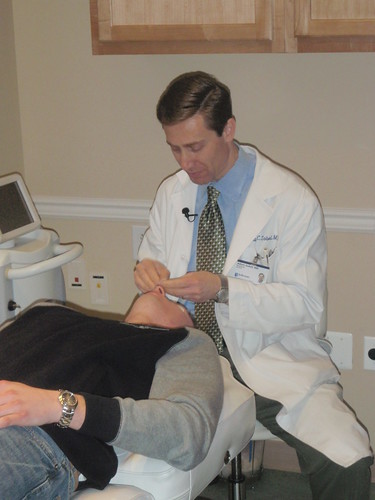
Dr. Adam Sobel prepares the patient’s face for an Isolaz acne laser treatment demonstration, a photo by CosmopolitanSkinCareSolutions on Flickr.
Nicki,
In January, you said you were going to try DermaDoctor Photodynamic Therapy Moisture, and then let us know what your thoughts are on it’s performance. (Original post on FutureDerm.com) I’m really interested in this product, but will wait to try it until I read your review of it.Thank you so much!
Bev
Dear Bev,
Well, unfortunately, I did try DermaDoctor Photodynamic Therapy Lotion, and despite the novel technology behind it, I didn’t like it.
In case you missed the earlier post (or perhaps would just like a recap), DermaDoctor Photodynamic Therapy Lotion is revolutionary because it converts UV light that hits your skin into red LED light, of the same wavelength found in dermatologists’ offices! How does it do this? A specific molecule, called a polyphenol, in Noni fruit (Morinda Citrifolia) absorbs UV light.
By the law of conservation of energy, the molecule must convert this absorbed light energy into a different form – i.e., heat, movement, and, most importantly, a focused red wavelength of light (648nm) – the same as red LEDs used in IPL laser treatments. I say “focused” because encapsulating the polyphenol with an inert tricalcium phosphate particle makes the product proven to transmit visible red light into the skin.
While all of this is certainly novel, there is one problem with DermaDoctor Photodynamic Therapy Lotion: There is a lot less red LED light exposure from it than a targeted IPL treatment, which has 800 (or more) focused diodes. That’s not to say that the red light exposure from the lotion isn’t beneficial for your skin – it is. But after a month of using DermaDoctor Photodynamic Therapy Lotion, I honestly didn’t notice much of a difference. Don’t get me wrong – DermaDoctor Photodynamic Therapy Lotion is a potent source of antioxidants (i.e., Noni fruit, green tea, white tea) and was hydrating without being irritating or causing breakouts. However, there was too little red light induction to make much of a difference.
I feel the company should reformulate DermaDoctor Photodynamic Therapy Lotion with a far high concentration of polyphenols, or market it exclusively for use in conjunction with a small at-home red LED device. After all, stronger red LED devices have significant anti-aging properties, creating a significant decrease in wrinkles (26-36 percent) and an increase in elasticity (14-19 percent) over the course of 12 weeks, as shown in a clinical study published in the journal Lasers in Surgery and Medicine. I feel that otherwise, a lot of consumers are being set up for disappointment (myself included).
I suspect we will see a lot more from this type of technology in the future, but I won’t be buying it again anytime soon.
Hope this helps!
Sincerely,
Got a Question for FutureDerm.com? Let us know on Facebook or Twitter!
Most Popular Daily Questions
- Do Hair Growth Supplements Really Work?
- What Can Be Done At-Home for Acne Scarring?
- How Can I Make My Hair More Youthful, Shiny, Full, and Thick?
- What Do YOU Use on Your Skin, FutureDerm?
- Which Skin Care Creams and Supplements Should Pregnant Women NOT Use?



